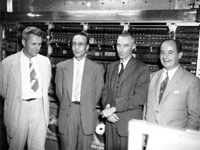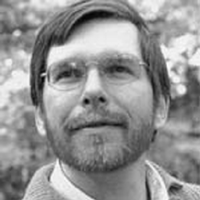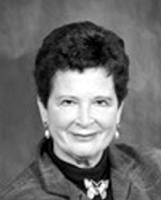SIAM Conference on CS&E: John von Neumann at 100: SIAM Celebrates a Rich Legacy
May 30, 2003

John von Neumann (far right) with (from left) Julian Bigelow, Herman Goldstine, and J. Robert Oppenheimer at the Institute for Advanced Study, 1952. Von Neumann and Oppenheimer "didn't much like each other," Peter Lax said at the SIAM conference, and the mathematicians at IAS (with the exception of Veblen) "didn't much like the computer." IAS terminated the project almost immediately following von Neumann's death (in 1957). Photo by Alan Richards, courtesy of the IAS archives.
Philip J. Davis
As a college junior I heard about a mathematical genius at Princeton named John von Neumann. I never met him but in 1950, as a brand new PhD, I heard him lecture at the International Congress of Mathematicians in Cambridge. He spoke about the computer and the human brain, an early talk on complexity; he later worked the talk up into a book, which was published posthumously.
I've scanned only one of his papers: the joint 1947 paper with Herman H. Goldstine in which they discussed the numerical solution of high-order linear algebraic equations. I recall thinking at the time that if the Establishment read this paper, they would realize that numerical analysis was as capable of generating deep theorems as any branch of mathematics and was not merely a raggle-taggle collection of recipes.
I read von Neumann's essay "The Mathematician" (in The Works of the Mind, edited by Robert B. Heywood, University of Chicago Press, 1947), in which he warned that by failing to pay attention to the nonmathematical world, mathematics risked becoming too inbred and sterile. I approved of that sentiment. I had not read an in-depth biography of von Neumann until my editor suggested that I do this piece. Checking my library, I found that there are at least a half dozen such biographies, not to mention any number of books in which he gets more than a passing nod. I suspect that writing about John von Neumann (1903-1957) will be a cottage industry for the indefinite future.
Through the years, von Neumann was to me largely a legend, the blazing sun among the dozens of Hungarian stars that had illuminated the world scientific scene for a century. Reuben Hersh and Vera John-Steiner have perceptively described this so-called Hungarian miracle (Mathematical Intelligencer, Volume 15, 1993). Of course, I heard stories, anecdotes. (Who didn't?) I regarded von Neumann as an icon, the pinnacle (for me) of unachievable brilliance, and when---as in "The Mathematician"---I found some piece of his philosophy that I agreed with, I displayed it as credentiation for my own views, in the hope that some of his aura would rub off.
As regards von Neumann's brilliance, Peter Lax said it all when he remarked that had the prizes existed at the time, von Neumann would have won three, perhaps three and a half, Nobels. Yes, von Neumann bestrode the mathematical world like a colossus; luckily, though, that world was sufficiently large that mathematical life beyond von Neumann was quite possible. I never made reference to his technical work in any of my mathematical papers, although it's true that I added a few epsilons to the theory of the transfinite diameter that Michael Fekete, tutor of a very young von Neumann, had created and brought to a high gloss. Not surprisingly, von Neumann's first publication (at the age of 19) was a joint paper with Fekete on that topic.
Now to the celebration held in San Diego on Monday evening, February 10, as part of the SIAM Conference on Computational Science and Engineering. Organized by Gene Golub and Joseph Grcar and chaired by the genial Gene, the session featured four speakers: William Aspray, Peter Lax, G.W. (Pete) Stewart, and Marina von Neumann Whitman. The first three names, I'm sure, are familiar to readers of SIAM News; Marina Whitman, the daughter of John von Neumann, is a professor of business administration at the University of Michigan.
The talks were biographical, laudatory, and, quite appropriately, reverential. Marina Whitman presented a warm and largely anecdotal view of growing up as the only child of such a towering figure. My eyebrows went up when she told us that her father worried quite a bit about the permanence of the legacy that he would leave. (More on the legacy question in a moment.)
Pete Stewart gave us a bird's-eye view of the seminal 1947 paper mentioned earlier, in which von Neumann and Goldstine introduced the notion of the condition number of a matrix and showed that, despite previous pessimistic inequalities of Harold Hotelling, positive definite matrices of high order could be inverted numerically if their condition was right. In this very rigorous paper, Stewart said, von Neumann and Goldstine used an extremely convoluted notation, which explains in part why the paper "has been as influential as it has been unread." Describing the development of the subject after von Neumann and Goldstine, Stewart stressed the backward analysis of J.H. Wilkinson.
In somewhat overlapping talks, William Aspray and Peter Lax concentrated on von Neumann's professional career and accomplishments. Aspray discussed in some depth von Neumann's contributions to computer design, numerical analysis, scientific computation, and automata theory. Lax spoke about von Neumann's early years in Hungary and Germany before turning to his work in the United States. Von Neumann was keenly aware of the importance of computational methods not only for military problems but also for problems like weather prediction, Lax said. Everyone in the audience recognizes von Neumann as the "father of the modern computer," Lax said, but not everyone is aware that he was also the "founding father of computational fluid dynamics."
What would surprise von Neumann if he were to wake up today? He might marvel, Lax suggested, at the ubiquity of computers, the sequencing of the genome, the Internet, that the world hasn't yet blown itself up.
To modify a quip of Disraeli: It makes us feel good to hear about great accomplishments laid on with a trowel. But I missed something in the evening's talks. One might suppose that nearly a half century after von Neumann's death, it would be acceptable to allude (even at a celebration) to a few of the less cheerful, less Olympian aspects of his career. We can learn not just from his successes, but also from his failures, his conflicts of various sorts, his politics. What did his philosophy of life appear to be, and how was all this related to his mathematics? Importantly, what do we now see as his legacy? Some of these topics were indeed mentioned, but only tangentially.
Post-World War II mathematicians---a good many of them, anyway---felt that von Neumann betrayed them---too strong a word?---in two ways. First, as a principal adviser on weapons to the military, he revealed himself as regards geopolitical policy to be, in a word, a hawk. (His hawkish positions are laid out clearly in P.R. Masani's 1990 biography Norbert Wiener.) Secondly, his increasing distance from abstract theory irritated pure theoreticians, culminating in the discomfort of the theoretical mathematicians and physicists at the Institute for Advanced Study when within its walls he set up a digital computer project for weather prediction. (A good discussion of that episode can be found in Norman Macrae's 1999 John von Neumann.)
Von Neumann's scientific legacy is firm; the merits of work deemed worthy of three and a half "Nobel" prizes cannot be denied. Of course, some things don't work out. Although, according to Marina Whitman, her father expected game theory to have a great influence on economics, his Theory of Games and Economic Behavior (von Neumann and Morgenstern, 1944) appears to have limited value in explaining economic phenomena. Like Lax, Marina Whitman speculated as to what the ghost of her father would think on returning to earth, surfing the Internet and finding it loaded with pop-up ads and porn. The best laid plans of mice and men go oft astray. The law of unintended consequences takes over, and the price civilization pays for coming out of the cave is a mixture of triumph and grief.
There are hundreds of metaphors for life: Life is a vale of tears, a dream, a joke. In As You Like It, Shakespeare says that life is a stage. What was von Neumann's metaphor? From a few indications I've gathered, it was that life is a game. Sensitive to the double-edged sword of knowledge and the idiocy of mankind, von Neumann's main legacy might be the deepening of the ancient dilemma of Prometheus.
Philip J. Davis, professor emeritus of applied mathematics at Brown University, is an independent writer, scholar, and lecturer. He lives in Providence, Rhode Island, and can be reached at [email protected].

Pete Stewart closed the von Neumann session at the SIAM conference with a discussion of "Numerical Inverting of Matrices of High Order," von Neumann and Goldstine's influential, yet largely unread, 1947 paper. (Stewart confessed to having read it himself only in preparation for the SIAM session.) Commenting on later innovators---Givens and Wilkinson among them---whose work was influenced by the paper, Stewart pointed out that von Neumann and Goldstine didn't establish the modern paradigm of rounding error analysis: "That was Wilkinson's contribution." But, Stewart said, "Few realize that von Neumann and Goldstine gave the first backward error analysis of a variant of Gaussian elimination. Only the problem they chose to analyze kept them from getting the full paradigm."

Von Neumann spent much of World War II on trains or in hotels, Bill Aspray told the audience. It was on a train in England, in 1943, that von Neumann wrote his first computing program---for calculation on a national accounting machine. "He got captured by this idea of computation," Aspray said; not long afterward, in a letter to a colleague in the U.S., von Neumann wrote: "I've developed an obscene interest in computation and I'll be returning to the United States a better and purer man." Waiting to board another train, from Aberdeen to Princeton, von Neumann was approached by a young Herman Goldstine. Years later, Goldstine recalled mentioning that he had a computer capable of 300 multiplications per second, on which a congenial conversation immediately took on the tone of a doctoral defense.

Marina von Neumann Whitman does not consider her father a very accurate prophet regarding "the practical application of his pioneering work." He was particularly interested not only in accurate weather forecasting, but also in climate modification, she said. "I don't think that progress in this area has been nearly as far or fast as he hoped or expected. Similarly, I think he anticipated that the theory of games would have a more immediate impact. . .

"Child prodigies are not rare in mathematics," Peter Lax said. "To grasp and solve mathematical problems, no understanding is needed of the wider context which can be acquired only through worldly experience. This has, for most mathematicians, the unfortunate consequence that they shy away from mathematical problems posed in a non-mathematical setting." In this, Lax continued, von Neumann differed from other mathematical prodigies: "Few have embraced real-world problems as wholeheartedly as von Neumann did."

